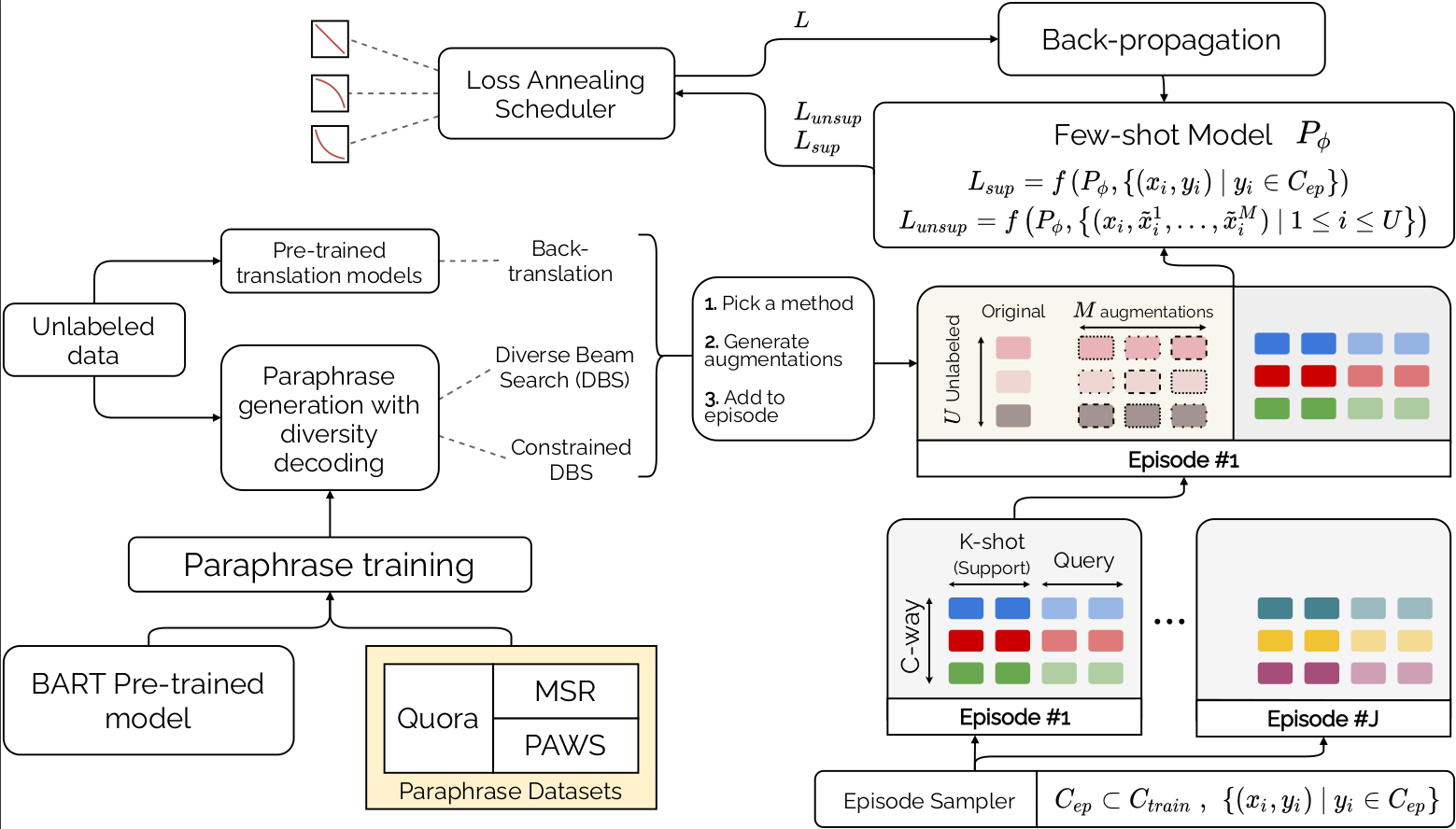This repository contains the official code for the paper PROTAUGMENT: Unsupervised diverse short-texts paraphrasing for intent detection meta-learning. In this paper, we aim at training a few-shot text classification model. To improve the robustness of our model, we introduced unlabeled data and paraphrases. The paper can be found here.
To run this code, we advise to create a specific virtual environment. Please note I used Python 3.6.9 in my code. Some other versions of python might not work.
# Environment creation
python3 -m virtualenv .venv --python=python3.6Then, install the required python libraries
# Activate environment
source .venv/bin/activate
# Install requirements
pip install -r requirements.txtPROTAUGMENT has the following architecture:
In this framework, two models are used:
- A paraphrase generation model
- An embedder model (usually a language model), which is used to do few-shot text classification
The paraphrase generation model is a BART (article, model) model, trained on the paraphrase generation task using 3 datasets: Google-PAWS, MSR, Quora. If you want to reproduce the results, the model is available on the 🤗 HuggingFace hub, named tdopierre/ProtAugment-ParaphraseGenerator
If you want to use another Seq2Seq model to generate paraphrases, feel free to change the --paraphrase-model-name-or-path and --paraphrase-tokenizer-name-or-path parameters.
If you want to train your own paraphrase generation model, follow the instructions in the paraphrase/fine-tune-BART directory.
For each dataset, we first fine-tune a language model on the dataset, on the masked language modeling task. Such models are available on the 🤗 HuggingFace hub:
| Dataset | Model Identifier | URL |
|---|---|---|
| BANKING77 | tdopierre/ProtAugment-LM-BANKING77 |
link |
| HWU64 | tdopierre/ProtAugment-LM-HWU64 |
link |
| Clinic150 | tdopierre/ProtAugment-LM-Clinic150 |
link |
| Liu | tdopierre/ProtAugment-LM-Liu |
link |
If you want to fine-tune your own language model, use the scripts available in the language_modeling directory.
If you want to run a single experiment using PROTAUGMENT, use models/proto/protaugment.sh. This script loads the correct environment and runs the python script models/proto/protaugment.py. The shell scripts passes the arguments to the python script, as can be seen in utils/scripts/run_protaugment.sh. I tried my best to document the different arguments in the protaugment.py. If anything is unclear, please reach out to @tdopierre directly.
To run the experiments obtained in the paper, use utils/scripts/protaugment/run_protaugment.sh
If you are using the SLURM job manager, you may use the alternative script run_protaugment-slurm.sh. This will break down each individual experiment into a separate job, and hence will run much faster (provided you have adequate hardware).
If you have your own paraphrases of unlabeled texts available, you can use them in PROTAUGMENT by specifiying the path in the --augmentation-data-path argument. As an example, you can have a look at the way I use augmentation issued by back-translation in the run_protaugment.sh script.
If you use this code or build upon it in your projects, please cite our paper
@article{Dopierre2021ProtAugmentUD,
title={ProtAugment: Unsupervised diverse short-texts paraphrasing for intent detection meta-learning},
author={Thomas Dopierre and C. Gravier and Wilfried Logerais},
journal={ArXiv},
year={2021},
volume={abs/2105.12995}
}
